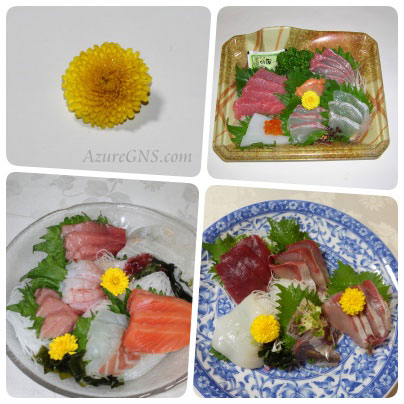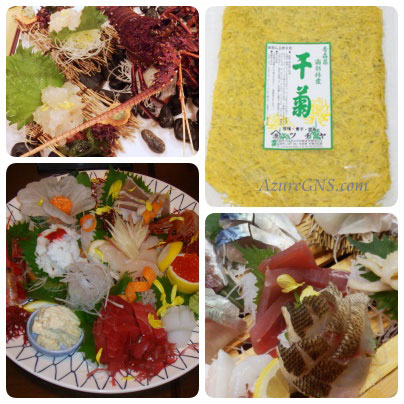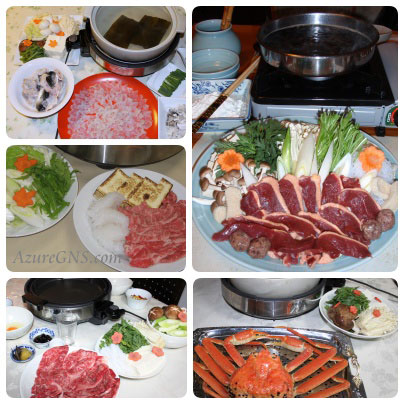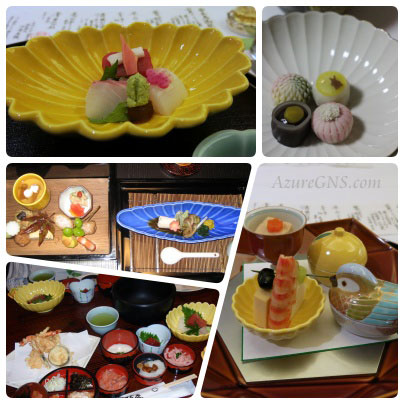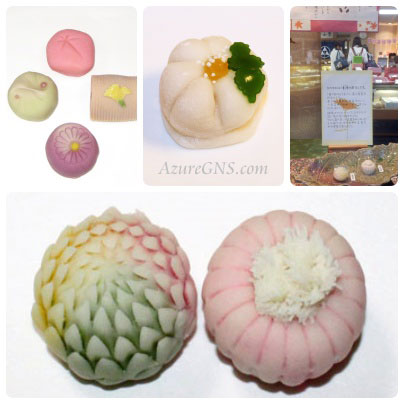Shokuyo-giku;
The Edible Chrysanthemums
食用菊は品種改良により香りや苦みを抑えたものです。古くから中国では菊を材料とした長寿に効果的とされる漢方薬、茶、酒が飲まれています。日本では奈良時代(710-794)に中国より食用菊が伝わり、江戸時代に菊を食べる習慣が庶民に広まりました。
Edible chrysanthemums have been bred to have less scent and bitterness than the ornamental flower varieties. Chrysanthemums have been used as an ingredient of herbal medicines, tea and alcoholic drinks for longevity since ancient times in China. Edible chrysanthemums were introduced to Japan from China in the Nara period (710-794). The custom of eating chrysanthemums spread among common people in the Edo period (1603-1868) in Japan.
菊の花はビタミン、ミネラル、カロチンが豊富に含まれ、葉や茎はビタミン、カロチン、カルシウム、クロロフィル(葉緑素)が豊富です。花、葉、茎ともにビタミンやミネラルが豊富に含まれ、コレステロール値や中性脂肪値低下、高血圧予防、発がん抑制効果があるという研究結果が出ています。またビタミンCやEが豊富のため美肌やアンチエイジングにも効果的です。葉には痰を切り、咳を抑える成分も含まれています。
Research shows the flowers of chrysanthemums are rich in vitamins, minerals and carotene, and their leaves and stalks contain abundant vitamins, carotene, calcium, and chlorophyll. The flowers, the leaves and the stalks have an effect on lowering cholesterol, decreasing the neutral fat level in blood, preventing high blood pressure and suppressing tumors. Vitamin C and E contained in chrysanthemums are also good for beautiful skin and anti-aging. The leaves contain components to get rid of phlegm and relieve coughing.
食用菊の小さな花はお刺身のつまに使われ、つま菊と呼ばれます。これらは彩りに使われるだけでなく、解毒作用があるため、刺身などの料理に添えられます。刺身の醤油に花びらを入れると、独特の香りを楽しむことができます。愛知県の食用小菊の国内シェアは90%に達しています。
Small flowers of edible chrysanthemums are used as sashimi-no-tsuma (garnish for raw fish), so it is called tsuma-giku. These small chrysanthemums are used for dishes such as sashimi (thin slices of raw fish) not only as garnishes but also for their detoxifying properties. If you put petals of them in soy sauce for sashimi, you can enjoy their unique scent. Aichi Prefecture has a 90% share of edible small chrysanthemums.
干菊は青森県八戸市の特産品のひとつです。八戸に行った時に有名な市場の八色センターで購入しました。大きな菊の花びらをむしり、乾かしたものです。刺身の上に散らしたり、和え物や酢の物に使ったりします。熱湯でさっと湯がいて料理に使います。
Dried edible chrysanthemums are one of the local specialties in Hachinohe City, Aomori Prefecture. I bought them in Hasshoku Center, a famous market, when I visited Hachinohe. The petals of big edible chrysanthemums are removed and dried, and they are scattered on sashimi and are also ingredients for ae-mono (Japanese style salad of chopped vegetables and other ingredients such as seafood seasoned with various seasonings) and su-no-mono (a cold dish seasoned with vinegar and other seasonings). People use them after boiling for a short time.
春菊は食用菊の独特の風味を持つ葉と茎です。1年中八百屋やスーパーで売られていますが、旬は11月から3月で、旬のものが一番美味しくて栄養価が高いです。春菊の調理法は、塩をひとつまみ入れた熱湯に茎から入れてさっと茹で、冷水に漬けて色止めをするか、ザルでお湯を切って団扇で扇いで冷まします。茹でて刻んだものに醤油と鰹節をかけておひたしにします。魚介類や鶏肉と混ぜ、ポン酢や醤油などで味をつけて酢の物や和え物にもします。春菊の胡麻和えや白和えも人気がある小鉢料理です。春菊の天ぷらも美味しいです。
Shungiku (garland chrysanthemum) consists of leaves and stalks of edible chrysanthemum which have a characteristic flavor. Shungiku, in season from November to March, is the most delicious and nutritious though it is sold at greengrocers and supermarkets all year round. How to cook shungiku is to put it in boiling hot water with a pinch of salt for a short time and then put it in cold water or drained in a colander and fanned to cool down lest it should lose its vivid green color. Boiled shungiku is chopped and seasoned with soy sauce and topped with thin slices of dried bonito to make ohitashi. Chopped boiled shungiku is mixed with seafood or chicken and seasoned with ponzu (soy sauce with citrus juice) or soy sauce to make su-no-mono and ae-mono. Goma-ae (chopped food seasoned with sesame) and shira-ae (chopped food dressed with tofu) of shungiku are popular side dishes. Tempura of shungiku is also delicious.
寒い日本の冬を生き抜くには、鍋物がピッタリです。家族で、大人数でも少人数でも、そしてたとえ1人でもかまいません。日本人が鍋物を好きな理由のひとつは、その多様性です。美味しく、栄養価が高く、緑色の彩りを添える春菊は、ほとんど全ての鍋物にぴったりです。美味しく、彩にもなる春菊は鍋物に欠かせません。その独特の風味は魚介類や肉の臭味を取る効果もあります。
Having nabe-mono (a hot pot dish cooked varies ingredient with broth or soup in a pot or a pan at the table) with your family, a large or a small group or even by yourself seems to be a great idea to survive a chilly winter in Japan. One of the reasons we Japanese like nabe-mono is its versatility. Shungiku is perfect with almost all nabe-mono because it tastes good and adds nutrition and a green color. Its unique flavor is effective to reduce the strong smell of seafood and meat.
最近は「サラダ春菊」と呼ばれる、品種改良の結果、さらに柔らかく、癖が少ない食べ易い品種も出回っていて、サラダや漬物などに使われ生のまま食べることもできます。春菊の匂いや味が苦手な好き嫌いのある人にも「サラダ春菊」はお薦めです。
Lately, as a result of selective breeding, some kinds of shungiku called “salad shungiku” are softer and milder; therefore, they can be ingredients of dishes without heating such as salad and pickles. I believe even a picky eater who doesn’t like the smell and taste of shungiku should try “salad shungiku”.
2013年(平成25年)の重陽の節句の夕食です。9月9日はまだ残暑が厳しいのですが、季節を先取りして秋らしいメニューにしました。日本の秋の食材の代表選手と言えば秋刀魚です。塩焼きにして、大根おろしを菊の形の小皿に入れ、酢橘を添えました。 鴨のスモークのスライスには菊の葉と花びらを添えました。イカ素麺を菊の葉と花びらをさっと湯がいて刻んだものを混ぜ、ポン酢で味を付けました。重陽の節句は栗の節句ともいわれ、栗ごはんがしばしば食べられます。秋が旬の野菜の南瓜、薩摩芋、エリンギを煮物にしました。無病息災を祈りながら、日本酒に菊の花びらを浮かべた菊酒を飲みました。
This is the dinner for Choyo-no-sekku in 2013 (Heisei 25th yr). Though it was still hot on September 9th, I prepared an autumn-like menu ahead of season. The representative autumn ingredient in Japan is sanma (mackerel pike or Pacific saury). I grilled sanma after sprinkling a pinch of salt and served it with daikon-oroshi (grated Japanese radish) and sudachi (a kind of Japanese citrus fruit) in a small chrysanthemum shaped dish. I served slices of smoked duck with leaves and petals of chrysanthemum. I mixed ika-somen (noodle-like squid sashimi) and chrysanthemum leaves and petals which were boiled for a short time and chopped and seasoned with ponzu. Choyo-no-sekku has another name, Kuri-no-sekku (the Chestnut Festival), so kuri-gohan (rice with chestnut) is often eaten. I made ni-mono (vegetables simmered in broth seasoned with soy-sauce, salt, and sugar) of vegetables in season such as pumpkin, sweet potato, and king rumpet mushroom. We drank Japanese sake with chrysanthemum petals while praying for our sound health.
洋食は大きなシンプルなお皿に盛り付ける傾向があります。一方、日本料理はさまざまな食器に余白を残して盛り付けるのが一般的です。伝統的な日本料理は食材や盛り付けは季節感をとても大切にしており、その美しさは芸術と呼ぶのにふさわしいでしょう。特に菊の開花時期の秋には、菊の形をした食器や、菊を描いた食器がよく使われます。
Western cuisine has a tendency to be arranged on a big plain plate. On the other hand, Japanese cuisine is usually served in varieties of vessels. The ingredients and arrangements of traditional Japanese cuisine emphasize seasonality and deserve to be called an art. The dishes and bowls in chrysanthemum shapes or with chrysanthemum pictures are often used especially in flowering time, autumn.
菊はしばしば和菓子の題材となります。これらは菊の練り切りです。練り切りは白餡に求肥やつくね芋やみじん粉や小麦などをつなぎに加え、混ぜて練った和菓子です。彫刻した木型、はさみ、ヘラなどで細工をしたり色を付けたりして、四季折々の花や風物を表します。
Chrysanthemums are often used as a motif of Japanese sweets. These are nerikiri in a chrysanthemum shape. Nerikiri is a Japanese sweet which is the mixture of shiro-an (sweetened white bean-paste), gyuhi (soft and delicate rice cake), tsukune-imo (Chinese yam), mijinko (powder of glutinous rice), or flour. A sculptured wooden model, a pair of scissors, a spatula, and food coloring are used to make a Japanese sweet of flowers and sceneries of each season.
(「菊の節句(重用)」に戻ります)
(Back to “The Chrysanthemum Festival”)
Copyright (C) Azure Global Network Services. All Rights Reserved.

